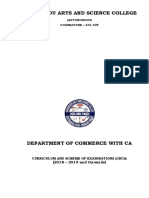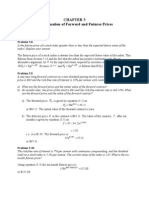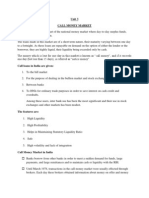333FF2 - Bond Pricing & Bond Pricing Theorems 1
333FF2 - Bond Pricing & Bond Pricing Theorems 1
Uploaded by
Sai PavanCopyright:
Available Formats
333FF2 - Bond Pricing & Bond Pricing Theorems 1
333FF2 - Bond Pricing & Bond Pricing Theorems 1
Uploaded by
Sai PavanOriginal Description:
Original Title
Copyright
Available Formats
Share this document
Did you find this document useful?
Is this content inappropriate?
Copyright:
Available Formats
333FF2 - Bond Pricing & Bond Pricing Theorems 1
333FF2 - Bond Pricing & Bond Pricing Theorems 1
Uploaded by
Sai PavanCopyright:
Available Formats
333FF2 Bond Pricing & Bond Pricing Theorems
BOND PRICING THEOREMS
1. Bond prices move inversely to
interest rate changes.
2. The longest the maturity of the
bond, the more sensitive it is to
changes in interest rates.
3. The price changes resulting
from equal absolute increases in
YTM are not symmetrical.
INTERNATIONAL FINANCIAL INVESTMENT
333FF2 Bond Pricing & Bond Pricing Theorems
4. The lower a bonds coupon, the
more sensitive its price will be to
given changes in interest rates.
These 4 principles were first derived and
proven from the basic bond valuation
equation in:
Burton G. Malkiel, Expectations, Bond
Prices and the Term Structure of Interest
Rates, Quarterly Journal of Economics,
1962 (p. 197-218)
INTERNATIONAL FINANCIAL INVESTMENT
333FF2 Bond Pricing & Bond Pricing Theorems
THEOREM 1: Bond prices move
inversely to interest rate changes.
When y P
When y P
Proof:
C = 20p.a., F = 100, N = 1.5 years,
y = 10% p.a.
Price of the bond = ?
INTERNATIONAL FINANCIAL INVESTMENT
333FF2 Bond Pricing & Bond Pricing Theorems
From bond valuation model:
P = 10/(1+0.05) + 10/(1+0.05)2 +
110/(1+0.05)3
P = 113.616
Assume that interest rates rise and let y
= 20% p.a.
With higher interest rates, the price of
the bond falls:
P = 100.00
INTERNATIONAL FINANCIAL INVESTMENT
333FF2 Bond Pricing & Bond Pricing Theorems
THEOREM 2: The longest the
maturity of the bond, the more
sensitive it is to changes in interest
rates.
Proof:
Original annual YTM 10% for all bonds
Bond A
Bond B
Bond C
Term to maturity
3 yrs
6 yrs
9 yrs
Annual Coupon
10
10
10
Current price
100
100
100
INTERNATIONAL FINANCIAL INVESTMENT
333FF2 Bond Pricing & Bond Pricing Theorems
Assume that interest rates fall by 2%,
so that YTM becomes 8%.
Term to maturity
Current price
Price sensitivity
(in )
Bond A
Bond B
Bond C
3 yrs
6 yrs
9 yrs
105.24
109.38
112.66
+ 5.24
+ 9.38
+ 12.66
A 2% fall in YTM causes a higher price
increase (+ 12.66) for the 9 year bond.
INTERNATIONAL FINANCIAL INVESTMENT
333FF2 Bond Pricing & Bond Pricing Theorems
Assume that interest rates increase
by 2%, so that YTM becomes 12%.
Bond A
Bond B
Bond C
3 yrs
6 yrs
9 yrs
Current price
95.08
91.62
89.17
Price sensitivity
(in )
- 4.92
- 8.38
- 10.83
Term to maturity
A 2% increase in YTM causes a higher
price fall (- 12.66) for the 9 year bond.
INTERNATIONAL FINANCIAL INVESTMENT
333FF2 Bond Pricing & Bond Pricing Theorems
THEOREM 3: The price changes
resulting from equal absolute
increases
in
YTM
are
not
symmetrical.
Proof:
Bond A
Bond B
Bond C
Price changes (in )
YTM falls by 2% + 5.24
+ 9.38
+ 12.66
YTM rises by 2% - 4.92
- 8.38
- 10.83
INTERNATIONAL FINANCIAL INVESTMENT
333FF2 Bond Pricing & Bond Pricing Theorems
For any given maturity, a x%
decrease in YTM causes a price rise
that is larger than the price loss
resulting from an equal x% increase
in YTM.
INTERNATIONAL FINANCIAL INVESTMENT
333FF2 Bond Pricing & Bond Pricing Theorems
10
THEOREM 4: The lower a bonds
coupon, the more sensitive its price
will be to given changes in interest
rates.
Proof:
Assume annual YTM 10% for all
bonds.
Bond A Bond B Bond C
Term to
maturity
Annual
Coupon
ZCB
3 years
30
15
Current 150.76 112.69 87.31
price
INTERNATIONAL FINANCIAL INVESTMENT
74.62
333FF2 Bond Pricing & Bond Pricing Theorems
11
Assume that interest rates increase by
2%, so that YTM becomes 12%.
Bond A Bond B Bond C Z C B
Term to
maturity
Annual
Coupon
Current
price
3 years
30
15
144.26 107.38 82.79 70.50
INTERNATIONAL FINANCIAL INVESTMENT
333FF2 Bond Pricing & Bond Pricing Theorems
12
The change in the price of the bond as a
percentage of the initial price is:
Annual
Coupon
% Change
in Price
Bond A
Bond B
Bond C
Zero
Coupon
Bond
30
15
- 4.31%
- 4.71%
- 5.18% - 5.52%
Notice that zero coupon bonds are the
most sensitive to changes in interest
rates.
INTERNATIONAL FINANCIAL INVESTMENT
333FF2 Bond Pricing & Bond Pricing Theorems
ADDITIONAL FACTORS
AFFECTING BOND VALUE
1.Taxation
2.Marketability
3.Call and Put Option provisions
INTERNATIONAL FINANCIAL INVESTMENT
13
333FF2 Bond Pricing & Bond Pricing Theorems
1. TAXATION
There is no Capital Gains Tax (CGT) on
most UK bonds.
Most investors pay tax on interest
income (coupon payments).
For the latter reason, investors in high
tax brackets prefer low coupon bonds.
For purely taxation purposes and for
maintaining market share, high coupon
bonds usually offer higher YTM to
compensate investors for tax losses.
INTERNATIONAL FINANCIAL INVESTMENT
14
333FF2 Bond Pricing & Bond Pricing Theorems
2. MARKETABILITY
(or LIQUIDITY)
Marketability or liquidity of a bond
depends on the ability to be bought or
sold
without
significant
price
concessions.
In general, the larger the size of a bond
issue, the greater its marketability.
INTERNATIONAL FINANCIAL INVESTMENT
15
333FF2 Bond Pricing & Bond Pricing Theorems
Institutional investors usually require
bond liquidity; liquid bonds tend to
trade at a premium.
The more marketable a bond is, the
lower its yield.
Credit ratings provide a good indication
of a bonds marketability.
INTERNATIONAL FINANCIAL INVESTMENT
16
333FF2 Bond Pricing & Bond Pricing Theorems
3. CALL AND
PROVISIONS
PUT
OPTION
Bonds often are issued with an option
provision.
Callable bonds (i.e. bonds with a call
option provision) give issuer the right to
redeem bond prior to maturity at a
specified price.
INTERNATIONAL FINANCIAL INVESTMENT
17
333FF2 Bond Pricing & Bond Pricing Theorems
Putable bonds (i.e. bonds with a put
option provision) give investor the right
to force issuer to redeem the bond prior
to maturity at a specified price.
Option provisions are exercised when
market interest rates and coupon rates
differ.
INTERNATIONAL FINANCIAL INVESTMENT
18
333FF2 Bond Pricing & Bond Pricing Theorems
Call provisions are more valuable when
interest rates fall or become more
volatile.
Callable bonds are redeemed when
market interest rates drop below coupon
rates.
This is because the bond price
increases. In this case, the issuer, in
order to avoid paying the appreciation
in the bonds value, exercises the call
option.
INTERNATIONAL FINANCIAL INVESTMENT
19
333FF2 Bond Pricing & Bond Pricing Theorems
Callable bonds restrict investors capital
gains. Therefore, callable bonds are
expected to offer high yields.
Low coupon bonds with call option
provisions attached are unlikely to be
called.
Callable bonds are more advantageous
to issuing companies.
Callable bonds are usually subject to
low credit ratings.
INTERNATIONAL FINANCIAL INVESTMENT
20
333FF2 Bond Pricing & Bond Pricing Theorems
Summary
The 4 bond pricing theorems have as
follows:
1. Bond prices move inversely to
interest rate changes.
2. The longest the maturity of the
bond, the more sensitive it is to
changes in interest rates.
3. The price changes resulting from
equal absolute increases in YTM
are not symmetrical.
INTERNATIONAL FINANCIAL INVESTMENT
21
333FF2 Bond Pricing & Bond Pricing Theorems
4. The lower a bonds coupon, the
more sensitive its price will be to
given changes in interest rates.
Additional factors affecting bond
value are taxation, marketability and
option provisions.
There is no Capital Gains Tax (CGT)
on most UK bonds. Most investors pay
tax on interest income (coupon
payments).
Marketability or liquidity of a bond
depends on the ability to be bought or
sold
without
significant
price
concessions.
INTERNATIONAL FINANCIAL INVESTMENT
22
333FF2 Bond Pricing & Bond Pricing Theorems
The more marketable a bond is, the
lower its yield.
Institutional investors usually require
bond liquidity; liquid bonds tend to
trade at a premium.
Option provisions are exercised when
market interest rates and coupon rates
differ.
Callable bonds are more advantageous
to issuing companies
INTERNATIONAL FINANCIAL INVESTMENT
23
You might also like
- Capital Budgeting Sums-Doc For PDF (Encrypted)Document7 pagesCapital Budgeting Sums-Doc For PDF (Encrypted)Prasad GharatNo ratings yet
- Prasanna ChandraDocument164 pagesPrasanna Chandraravi_vadgama_157% (7)
- Lesson 1 Introduction To Law and The Meaning and EssentialsDocument201 pagesLesson 1 Introduction To Law and The Meaning and EssentialsSandip Dankhara100% (2)
- Interconnected Stock Exchange (ISE)Document9 pagesInterconnected Stock Exchange (ISE)Anoop KoshyNo ratings yet
- Analysis of Working Capital of Ambuja and ACC Cement Final ReportDocument13 pagesAnalysis of Working Capital of Ambuja and ACC Cement Final ReportAnuj GoelNo ratings yet
- Chapter 9Document20 pagesChapter 9harshadampgdmNo ratings yet
- Pricing Strategy Report - Group 5 - Maruti BalenoDocument19 pagesPricing Strategy Report - Group 5 - Maruti BalenodwnpiyushNo ratings yet
- Numericals On Cost of Capital and Capital StructureDocument2 pagesNumericals On Cost of Capital and Capital StructurePatrick AnthonyNo ratings yet
- Book BuildingDocument10 pagesBook BuildingSaad Mahmood100% (1)
- Adhish Sir'S Classes 1: Chapter - Cost of CapitalDocument8 pagesAdhish Sir'S Classes 1: Chapter - Cost of CapitaladhishcaNo ratings yet
- Chapter 5 Ethical Behaviour & Implications For AccountantsDocument18 pagesChapter 5 Ethical Behaviour & Implications For Accountantsmanoj parmarNo ratings yet
- Leasing Solution Ca-Final SFM (Full)Document32 pagesLeasing Solution Ca-Final SFM (Full)Pravinn_Mahajan80% (5)
- Ba5011 Merchant Banking and Financial Services Reg 17 Question BankDocument5 pagesBa5011 Merchant Banking and Financial Services Reg 17 Question BankAnusha kanmaniNo ratings yet
- Case US-64 ControversyDocument4 pagesCase US-64 ControversyBiweshNo ratings yet
- Issue ManagementDocument30 pagesIssue Managementmohanbkp100% (2)
- 1164914469ls 1Document112 pages1164914469ls 1krishnan bhuvaneswariNo ratings yet
- Master Fuel 1957Document2 pagesMaster Fuel 1957namrvora072504No ratings yet
- Kolhan University BBA SEM 5 Previous Year Question Papers of 2018 and 2022Document19 pagesKolhan University BBA SEM 5 Previous Year Question Papers of 2018 and 2022rahulmehtagamesNo ratings yet
- Financial Performance Analysis of HDFC Using Dupont AnalysisDocument7 pagesFinancial Performance Analysis of HDFC Using Dupont AnalysisMohmmedKhayyumNo ratings yet
- Case Study: QuestionsDocument1 pageCase Study: Questionssanjaymanocha100% (1)
- Finance STPDocument30 pagesFinance STPayushithakur918No ratings yet
- IAPM Selected NumericalsDocument18 pagesIAPM Selected NumericalsPareen DesaiNo ratings yet
- From Beranek To Stone ModelDocument9 pagesFrom Beranek To Stone ModelShaikh Saifullah KhalidNo ratings yet
- Business Ethics in HaldiramDocument29 pagesBusiness Ethics in HaldiramShivam LohiaNo ratings yet
- Aditi's ABH Samvedna ReportDocument18 pagesAditi's ABH Samvedna Reportsajalasati98No ratings yet
- IFM Module 6 ProblemsDocument7 pagesIFM Module 6 ProblemsAlissa BarnesNo ratings yet
- Assignment Financial ManagementDocument5 pagesAssignment Financial Managementhoneyverma30100% (1)
- Factors Affecting Valuation of SharesDocument6 pagesFactors Affecting Valuation of SharesSneha ChavanNo ratings yet
- Section 1: Case Study Topic: Merger of Flipkart and Myntra Strategy: Merger and AcquisitionDocument8 pagesSection 1: Case Study Topic: Merger of Flipkart and Myntra Strategy: Merger and AcquisitionMuskan MannNo ratings yet
- Chap 8 - Advanced Issues in ValuationDocument50 pagesChap 8 - Advanced Issues in Valuationrafat.jalladNo ratings yet
- Project Synopsis Mba HR Stress Management in Bpo SectorDocument10 pagesProject Synopsis Mba HR Stress Management in Bpo Sectorsarla0% (1)
- Leverage Unit-4 Part - IIDocument34 pagesLeverage Unit-4 Part - IIAstha ParmanandkaNo ratings yet
- AAI Junior Executive (Finance) 2018 Previous Year PaperDocument50 pagesAAI Junior Executive (Finance) 2018 Previous Year PaperCHARTBUSTER TRADENo ratings yet
- Session-SDC 4 Facility LocationDocument28 pagesSession-SDC 4 Facility LocationminspNo ratings yet
- Pom - Inventory ManagementDocument5 pagesPom - Inventory ManagementMURALI KRISHNA VELAVETI Dr.No ratings yet
- Determination of Forward and Futures Prices: Practice QuestionsDocument3 pagesDetermination of Forward and Futures Prices: Practice Questionshoai_hm2357No ratings yet
- Marginal Costing and Cost Volume Profit AnalysisDocument5 pagesMarginal Costing and Cost Volume Profit AnalysisAbu Aalif RayyanNo ratings yet
- 13 Marginal CostingDocument5 pages13 Marginal CostingPriyanka ShewaleNo ratings yet
- Unit 3 Call Money MarketDocument14 pagesUnit 3 Call Money MarketsadathnooriNo ratings yet
- Receivable Management KanchanDocument12 pagesReceivable Management KanchanSanchita NaikNo ratings yet
- Legal and Procedural Aspects of MergerDocument8 pagesLegal and Procedural Aspects of MergerAnkit Kumar (B.A. LLB 16)No ratings yet
- SBI & BMB MergerDocument12 pagesSBI & BMB MergerShubham naharwal (PGDM 17-19)No ratings yet
- Capital BudgetingDocument38 pagesCapital BudgetingTaha MadniNo ratings yet
- Profit and Loss Pre and Profit IncorporationDocument37 pagesProfit and Loss Pre and Profit IncorporationJacob SphinixNo ratings yet
- BCOM 3rd and 4th Sem Syallbus NEPDocument37 pagesBCOM 3rd and 4th Sem Syallbus NEPgfgcw yadgirNo ratings yet
- Friends Break Even AnalysisDocument5 pagesFriends Break Even AnalysisBuenalee Dela PazNo ratings yet
- Chapter 10 - FINANCIAL ARITHMETICS FOR EQUITY & BONDSDocument18 pagesChapter 10 - FINANCIAL ARITHMETICS FOR EQUITY & BONDSAmrita Bhat0% (1)
- Swap Sums With Solution PDFDocument10 pagesSwap Sums With Solution PDFsagar mNo ratings yet
- Evolution and Role of Financial Services Companies inDocument11 pagesEvolution and Role of Financial Services Companies inRicha Sonali0% (2)
- Sip Handbook OF IBSDocument40 pagesSip Handbook OF IBSPriyanka AgarwalNo ratings yet
- Working Capital MGTDocument14 pagesWorking Capital MGTrupaliNo ratings yet
- Cost of Capital (Ch-3)Document26 pagesCost of Capital (Ch-3)Neha SinghNo ratings yet
- Presentation On Consumer FinanceDocument27 pagesPresentation On Consumer FinanceswatigouravNo ratings yet
- NISM Case StudyDocument14 pagesNISM Case Studymissionupscias2016No ratings yet
- Guidelines For Extending Equity Support To Housing Finance CompaniesDocument3 pagesGuidelines For Extending Equity Support To Housing Finance CompaniessrirammaliNo ratings yet
- FM - Dividend Policy and Dividend Decision Models (Cir 18.3.2020)Document129 pagesFM - Dividend Policy and Dividend Decision Models (Cir 18.3.2020)Rohit PanpatilNo ratings yet
- What Are Some Examples of HR Events at A B-School College FestDocument1 pageWhat Are Some Examples of HR Events at A B-School College Festgorika chawlaNo ratings yet
- Richa Food Case EditedDocument3 pagesRicha Food Case Editedvishal nigamNo ratings yet
- GST Tally ERP9 English: A Handbook for Understanding GST Implementation in TallyFrom EverandGST Tally ERP9 English: A Handbook for Understanding GST Implementation in TallyRating: 5 out of 5 stars5/5 (1)
- Bond ValuationDocument20 pagesBond ValuationSaravana KrishnanNo ratings yet
- Kandi. Sai Pavan Kumar: Career ObjectiveDocument2 pagesKandi. Sai Pavan Kumar: Career ObjectiveSai PavanNo ratings yet
- India's Journey Towards Cashless Economy-A Study: K. Sai Pavan KumarDocument9 pagesIndia's Journey Towards Cashless Economy-A Study: K. Sai Pavan KumarSai PavanNo ratings yet
- Feedback FormDocument6 pagesFeedback FormSai PavanNo ratings yet
- Logistics and Supply Chain Mangement: Basic Service CapabilityDocument8 pagesLogistics and Supply Chain Mangement: Basic Service CapabilitySai PavanNo ratings yet
- "Retail Management": Book StoresDocument1 page"Retail Management": Book StoresSai PavanNo ratings yet
- Mini ProjectDocument10 pagesMini ProjectSai PavanNo ratings yet
- Company Analysis: Presented By: Bishnu Kumar Singh R E G D N O: 1 5 3 3 1 E 0 0 1 2Document9 pagesCompany Analysis: Presented By: Bishnu Kumar Singh R E G D N O: 1 5 3 3 1 E 0 0 1 2Sai PavanNo ratings yet
- Visit Note: Ansal Properties and Infrastructure Limited (APIL)Document5 pagesVisit Note: Ansal Properties and Infrastructure Limited (APIL)royrakeshNo ratings yet
- Chapter 17Document15 pagesChapter 17Monalisa SethiNo ratings yet
- 664049fa0f5a76cadab99f31-1715489306-ACC 124 - HO-17 - Reclassification of Financial AssetsDocument4 pages664049fa0f5a76cadab99f31-1715489306-ACC 124 - HO-17 - Reclassification of Financial AssetsJames Cañada GatoNo ratings yet
- CBSE Class 12 Entrepreneurship Marking Scheme Question Paper 2019-20Document15 pagesCBSE Class 12 Entrepreneurship Marking Scheme Question Paper 2019-20amdNo ratings yet
- European Union Andorra Income Tax FlatDocument2 pagesEuropean Union Andorra Income Tax FlatПолина УсачеваNo ratings yet
- Auto ChartistDocument23 pagesAuto ChartistSehat TanNo ratings yet
- DissertationDocument209 pagesDissertationanon_259017833No ratings yet
- Maths in Stock Market Ashar Ghawte 4Document38 pagesMaths in Stock Market Ashar Ghawte 4AMITNo ratings yet
- Walmart Annual ReportDocument323 pagesWalmart Annual Report1711........No ratings yet
- Company Secretary Roles in Financial MarketsDocument28 pagesCompany Secretary Roles in Financial MarketsOloo Yussuf Ochieng'No ratings yet
- 5, 6 & 7 Capital BudgetingDocument42 pages5, 6 & 7 Capital BudgetingNaman AgarwalNo ratings yet
- 01 Capital Budgeting PDFDocument33 pages01 Capital Budgeting PDFSardonna FongNo ratings yet
- Stock Exchange IndicesDocument19 pagesStock Exchange IndicesBunu MarianaNo ratings yet
- Financial Analysis of Telenor Part 6Document3 pagesFinancial Analysis of Telenor Part 6Muhammad Ehtasham ul HassanNo ratings yet
- Choosing The Wrong Pricing Strategy Can Be A Costly Mistake - Knowledge at WhartonDocument8 pagesChoosing The Wrong Pricing Strategy Can Be A Costly Mistake - Knowledge at WhartonPrabhas AnushkaNo ratings yet
- 15.preparation of ProposalDocument48 pages15.preparation of Proposalpuran1234567890No ratings yet
- Morning Sheet TemplateDocument4 pagesMorning Sheet TemplatedkokkeNo ratings yet
- Capital Budgeting (Under Risk and Uncertainty) and MethodsDocument12 pagesCapital Budgeting (Under Risk and Uncertainty) and MethodsChetan PatelNo ratings yet
- Walgreens Stock PitchDocument15 pagesWalgreens Stock Pitchapi-606135047No ratings yet
- IBF Short Notes Chapter 3Document4 pagesIBF Short Notes Chapter 3Minhaj TariqNo ratings yet
- What Are Futures and Options?Document14 pagesWhat Are Futures and Options?Happy SinghNo ratings yet
- Part 4: Operating & Organizational Plans: Building An ISP Business PlanDocument5 pagesPart 4: Operating & Organizational Plans: Building An ISP Business Planrinara_aquinoNo ratings yet
- The Case For Community BanksDocument19 pagesThe Case For Community BanksSatpreet HoraNo ratings yet
- Uncertainty and Consumer BehaviorDocument34 pagesUncertainty and Consumer BehaviorArif AdityaNo ratings yet
- AIBL Annual Report-2017Document206 pagesAIBL Annual Report-2017Sheikh RakinNo ratings yet
- Jefferies-Global Secondary Market Review-January 2023Document10 pagesJefferies-Global Secondary Market Review-January 2023Chuan JiNo ratings yet
- Understanding Financial StatementsDocument77 pagesUnderstanding Financial Statementsshivam_dubey4004100% (1)
- Investopedia. Using - The Greeks - To Undersand OptionsDocument5 pagesInvestopedia. Using - The Greeks - To Undersand OptionsEnrique BustillosNo ratings yet
- Exercises LBODocument2 pagesExercises LBORafael Lizana ZúñigaNo ratings yet
































































































